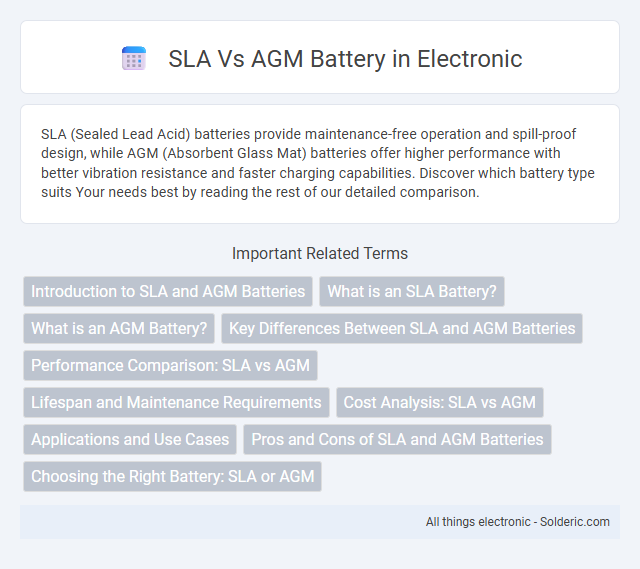SLA (Sealed Lead Acid) batteries provide maintenance-free operation and spill-proof design, while AGM (Absorbent Glass Mat) batteries offer higher performance with better vibration resistance and faster charging capabilities. Discover which battery type suits Your needs best by reading the rest of our detailed comparison.
Comparison Table
| Feature | SLA Battery | AGM Battery |
|---|---|---|
| Full Name | Sealed Lead Acid | Absorbent Glass Mat |
| Technology | Lead acid with liquid or gel electrolyte | Lead acid with absorbed glass mat separator |
| Maintenance | Maintenance-free | Maintenance-free |
| Charge Efficiency | Lower (around 85%) | Higher (up to 95%) |
| Cycle Life | 300-500 cycles | 500-1000 cycles |
| Self-Discharge Rate | 3-5% per month | 1-3% per month |
| Vibration Resistance | Moderate | High |
| Cost | Lower | Higher |
| Common Applications | UPS, emergency lighting, small vehicles | Motorcycles, solar systems, high-performance vehicles |
Introduction to SLA and AGM Batteries
SLA (Sealed Lead Acid) and AGM (Absorbent Glass Mat) batteries are both types of lead-acid batteries designed for maintenance-free operation with sealed construction to prevent leaks. AGM batteries utilize a fiberglass mat separator to absorb the electrolyte, offering improved vibration resistance, faster charging, and better performance in deep cycling compared to traditional SLA batteries. Understanding the differences helps you select the appropriate battery based on durability, recharge efficiency, and application requirements.
What is an SLA Battery?
An SLA battery, or Sealed Lead Acid battery, is a type of rechargeable battery characterized by its sealed, maintenance-free design and ability to provide reliable power in a compact, spill-proof form. These batteries use a gel or absorbed glass mat (AGM) electrolyte to reduce evaporation and leakage, making them suitable for emergency lighting, UPS systems, and mobility devices. Understanding the difference in construction and performance between SLA and AGM batteries helps you choose the right power source for your specific application.
What is an AGM Battery?
An AGM battery, or Absorbent Glass Mat battery, uses a fiberglass mat to absorb the electrolyte, enhancing durability and preventing leaks compared to traditional SLA (Sealed Lead Acid) batteries. AGM batteries offer faster charging, better deep-cycle performance, and increased resistance to vibration, making them ideal for applications where reliability and maintenance-free operation are crucial. Your choice between AGM and SLA depends on factors like energy demands, lifespan, and environmental conditions.
Key Differences Between SLA and AGM Batteries
SLA batteries use a liquid electrolyte, while AGM batteries utilize absorbed glass mat technology, leading to better vibration resistance and lower internal resistance in AGM units. AGM batteries generally offer superior charge acceptance, faster recharge times, and longer cycle life compared to traditional SLA batteries. The sealed design of AGM batteries reduces maintenance needs and minimizes the risk of acid leaks, making them ideal for high-performance and deep-cycle applications.
Performance Comparison: SLA vs AGM
AGM batteries deliver higher performance with faster recharge times and superior cold-cranking amps compared to SLA batteries, making them ideal for high-demand applications. SLA batteries offer reliable performance with lower cost and maintenance, but their energy density and lifecycle are typically outpaced by AGM technology. AGM batteries also exhibit better resistance to vibration and temperature extremes, enhancing overall durability and operational efficiency.
Lifespan and Maintenance Requirements
AGM batteries typically offer a longer lifespan, averaging 4 to 7 years, compared to SLA batteries, which usually last around 3 to 5 years. Maintenance requirements for AGM batteries are minimal due to their sealed design, eliminating the need for regular water refilling, while SLA batteries require periodic electrolyte checks and topping up. Your choice between these batteries should consider the balance between longevity and maintenance convenience based on your specific power needs.
Cost Analysis: SLA vs AGM
SLA batteries generally offer a lower upfront cost compared to AGM batteries, making them a budget-friendly choice for basic power needs. AGM batteries deliver a longer lifespan and higher performance efficiency, potentially lowering total ownership costs despite their higher initial price. Evaluating your usage patterns and expected battery lifespan helps determine the most cost-effective option for your application.
Applications and Use Cases
SLA batteries are ideal for backup power in uninterruptible power supplies (UPS), emergency lighting, and small-scale renewable energy systems due to their sealed design and low maintenance. AGM batteries excel in high-performance applications such as marine equipment, off-road vehicles, and advanced solar energy setups because of their superior charge acceptance and vibration resistance. Understanding your specific application requirements ensures you select the right battery technology for optimal performance and longevity.
Pros and Cons of SLA and AGM Batteries
SLA (Sealed Lead Acid) batteries offer affordability and ease of maintenance but suffer from lower energy density and shorter lifespan compared to AGM (Absorbent Glass Mat) batteries. AGM batteries provide superior performance with higher energy density, faster charging, better vibration resistance, and longer cycle life, although they come at a higher cost and require careful charging to avoid damage. Choosing between SLA and AGM depends on application needs balancing budget constraints with performance and durability requirements.
Choosing the Right Battery: SLA or AGM
Choosing the right battery between SLA (Sealed Lead Acid) and AGM (Absorbent Glass Mat) depends on your specific application and performance needs. AGM batteries offer superior vibration resistance, faster recharge times, and better deep discharge capabilities, making them ideal for high-demand or off-grid systems. Your choice should consider factors like maintenance requirements, cost, and expected battery lifespan to ensure optimal power reliability.
SLA vs AGM battery Infographic

 solderic.com
solderic.com